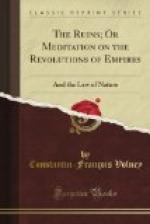over every thing, like the flower of the Lotos
on the waters.) A man at the helm of a ship,
adds Jamblicus, is descriptive of the sun which
governs all. And Porphyry tells us that the sun
is also represented by a man in a ship resting
upon an amphibious crocodile (emblem of air and
water).
“At Elephantine they worshipped the figure of a man in a sitting posture, painted blue, having the head of a ram, and the horns of a goat which encompassed a disk; all which represented the sun and moon’s conjunction at the sign of the ram; the blue color denoting the power of the moon, at the period of junction, to raise water into the clouds. Euseb. Proecep. Evang. p. 116.
“The hawk is an
emblem of the sun and of light, on account
of his rapid flight
and his soaring into the highest regions
of the air where light
abounds.
A fish is the emblem of aversion, and the Hippopotamus of violence, because it is said to kill its father and to ravish its mother. Hence, says Plutarch, the emblematical inscription of the temple of Sais, where we see painted on the vestibule, 1. A child, 2. An old man, 3. A hawk, 4. A fish, 5. A hippopotamus: which signify, 1. Entrance, into life, 2. Departure, 3. God, 4. Hates, 5. Injustice. See Isis and Osiris.
“The Egyptians, adds he, represent the world by a Scarabeus, because this insect pushes, in a direction contrary to that in which it proceeds, a ball containing its eggs, just as the heaven of the fixed stars causes the revolution of the sun, (the yolk of an egg) in an opposite direction to its own.
“They represent the world also by the number five, being that of the elements, which, says Diodorus, are earth, water, air, fire, and ether, or spiritus. The Indians have the same number of elements, and according to Macrobius’s mystics, they are the supreme God, or primum mobile, the intelligence, or mens, born of him, the soul of the world which proceeds from him, the celestial spheres, and all things terrestrial. Hence, adds Plutarch, the analogy between the Greek pente, five, and pan all.
“The ass,” says he again, “is the emblem of Typhon, because like that animal he is of a reddish color. Now Typhon signifies whatever is of a mirey or clayey nature; (and in Hebrew I find the three words clay, red, and ass to be formed from the same root hamr). Jamblicus has farther told us that clay was the emblem of matter and he elsewhere adds, that all evil and corruption proceeded from matter; which compared with the phrase of Macrobius, all is perishable, liable to change in the celestial sphere, gives us the theory, first physical, then moral, of the system of good and evil of the ancients.”
“Finally, a third cause of confusion was the civil organization of ancient states. When the people began to apply themselves to agriculture, the formation of a rural calendar, requiring a continued




